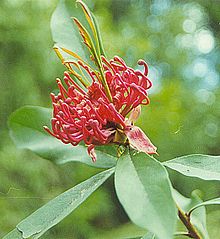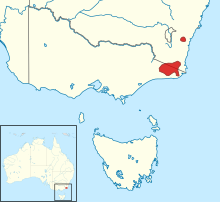Telopea oreades
| Gippsland waratah | |
|---|---|
 |
|
| Scientific classification | |
| Kingdom: | Plantae |
| (unranked): | Angiosperms |
| (unranked): | Eudicots |
| Order: | Proteales |
| Family: | Proteaceae |
| Genus: | Telopea |
| Species: | T. oreades |
| Binomial name | |
|
Telopea oreades F.Muell., 1861 |
|
 |
|
| Range in southeastern Australia (in red) | |
| Synonyms | |
|
Hylogyne oreades (F.Muell.) Kuntze |
|
Hylogyne oreades (F.Muell.) Kuntze
Telopea oreades, commonly known as the Gippsland-, mountain- or Victorian waratah, is a large shrub or small tree in the family Proteaceae. Native to southeastern Australia, it is found in wet sclerophyll forest and rainforest on rich acidic soils high in organic matter. No subspecies are recognised, though a northern isolated population hybridises extensively with the Braidwood waratah (T. mongaensis). Reaching a height of up to 19 metres (62 feet), T. oreades grows with a single trunk and erect habit. It has dark green leaves with prominent veins that are 11–28 centimetres (4.3–11 in) long and 1.5–6 cm (0.6–2.4 in) wide. The red flower heads, known as inflorescences, appear in late spring. Each is composed of up to 60 individual flowers.
In the garden, T. oreades grows in soils with good drainage and ample moisture in part-shaded or sunny positions. Several commercially available cultivars that are hybrid forms with T. speciosissima have been developed, such as the 'Shady Lady' series. The timber is hard and has been used for making furniture and tool handles.
Telopea oreades grows as a large shrub or narrow tree 9–19 m (30–62 ft) high with a trunk reaching 45 to 60 cm (18 to 24 in) in diameter. Greyish brown, the trunk is thin in relation to the tree's height and not buttressed. Its surface is smooth with horizontal lenticels and warty protuberances. Smaller branches are more brown and smooth. Young plants have a much more erect habit than other members of the genus Telopea and their stems have a distinct reddish tinge. The shiny dark green leaves are arranged alternately along the stems. The leaves are narrow- to , and measure 11–28 centimetres (4.3–11 in) long and 1.5–6 cm (0.59–2.36 in) wide. They have a sunken midrib on the upperside (and corresponding ridge on the underside) with four to six pairs of lateral veins visible at a 45 degree angle to the midline. They veer and converge to form an easily seen vein that runs around 0.5 cm (0.20 in) inside the leaf margin. The undersurface is paler and greyer. When dried, the leaves appear to have a granular texture.
...
Wikipedia
